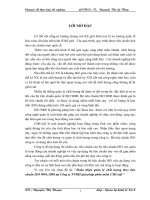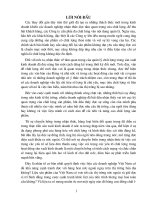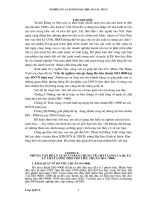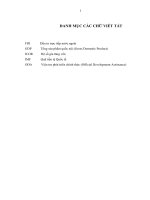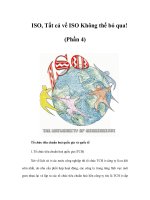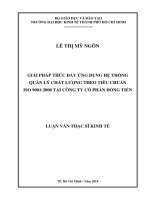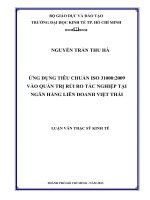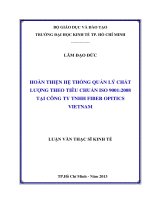Tiêu Chuẩn Iso 11608-3-2012.Pdf
Bạn đang xem bản rút gọn của tài liệu. Xem và tải ngay bản đầy đủ của tài liệu tại đây (160.01 KB, 16 trang )
INTERNATIONAL
STANDARD
ISO
11608-3
Second edition
2012-10-01
Needle-based injection systems for medical
use — Requirements and test methods —
Part 3:
Finished containers
Systèmes d’injection à aiguille pour usage médical — Exigences et
méthodes d’essai —
Partie 3: Conteneurs prêts à l’emploi
Reference number
ISO 11608-3:2012(E)
--`,`,,,,,```,````,`,,`,`````-`-`,,`,,`,`,,`---
Copyright International Organization for Standardization
Provided by IHS under license with ISO
No reproduction or networking permitted without license from IHS
© ISO 2012
Licensee=University of Alberta/5966844001, User=sharabiani, shahramfs
Not for Resale, 12/03/2013 08:45:16 MST
ISO 11608-3:2012(E)
COPYRIGHT PROTECTED DOCUMENT
©
ISO 2012
All rights reserved. Unless otherwise specified, no part of this publication may be reproduced or utilized in any form or by any means,
electronic or mechanical, including photocopying and microfilm, without permission in writing from either ISO at the address below or ISO’s
member body in the country of the requester.
ISO copyright office
Case postale 56 • CH-1211 Geneva 20
Tel. + 41 22 749 01 11
Fax + 41 22 749 09 47
Web www.iso.org
Published in Switzerland
--`,`,,,,,```,````,`,,`,`````-`-`,,`,,`,`,,`---
ii
Copyright International Organization for Standardization
Provided by IHS under license with ISO
No reproduction or networking permitted without license from IHS
© ISO 2012 – All rights reserved
Licensee=University of Alberta/5966844001, User=sharabiani, shahramfs
Not for Resale, 12/03/2013 08:45:16 MST
ISO 11608-3:2012(E)
Foreword
ISO (the International Organization for Standardization) is a worldwide federation of national standards bodies
(ISO member bodies). The work of preparing International Standards is normally carried out through ISO
technical committees. Each member body interested in a subject for which a technical committee has been
established has the right to be represented on that committee. International organizations, governmental and
non-governmental, in liaison with ISO, also take part in the work. ISO collaborates closely with the International
Electrotechnical Commission (IEC) on all matters of electrotechnical standardization.
International Standards are drafted in accordance with the rules given in the ISO/IEC Directives, Part 2.
The main task of technical committees is to prepare International Standards. Draft International Standards
adopted by the technical committees are circulated to the member bodies for voting. Publication as an
International Standard requires approval by at least 75 % of the member bodies casting a vote.
Attention is drawn to the possibility that some of the elements of this document may be the subject of patent
rights. ISO shall not be held responsible for identifying any or all such patent rights.
ISO 11608-3 was prepared by Technical Committee ISO/TC 84, Devices for administration of medicinal
products and intravascular catheters.
This second edition cancels and replaces the first edition (ISO 11608-3:2000), which has been technically revised.
ISO 11608 consists of the following parts, under the general title Needle-based injection systems for medical
use — Requirements and test methods:
—
Part 1: Needle-based injection systems
—
Part 2: Needles
—
Part 3: Finished containers
—
Part 4: Requirements and test methods for electronic and electromechanical pen-injectors
—
Part 5: Automated functions
--`,`,,,,,```,````,`,,`,`````-`-`,,`,,`,`,,`---
iii
© ISO 2012 – All rights reserved
Copyright International Organization for Standardization
Provided by IHS under license with ISO
No reproduction or networking permitted without license from IHS
Licensee=University of Alberta/5966844001, User=sharabiani, shahramfs
Not for Resale, 12/03/2013 08:45:16 MST
ISO 11608-3:2012(E)
Introduction
This part of ISO 11608 is applicable to containers that are provided pre-filled, or that are to be filled by the user
with medicinal products intended by the manufacturer to be used with needle-based injection systems (NIS),
as covered by ISO 11608.
The previous edition of this part of ISO 11608 introduced the concept of interchangeability and the labelling
designation of Type A (i.e. interchangeable) and non-Type A for needles and containers.
The previous edition of this part of ISO 11608 also only addressed cartridges as the drug container. This was
consistent with the scope of ISO 11608 (all parts), which was previously restricted to cartridge-based injection
pens. The scope of the latest revision of ISO 11608 (all parts) has been expanded beyond pen injectors and
now includes all NIS, resulting in additional possibilities for compatible containers, including syringes to be
used with NIS, and potentially other containers not yet defined. In order to preserve this information, this part
of ISO 11608 maintains those specifications, requirements and dimensions. It is important to stress that the
design requirements related to system function have been maintained as a guide to assist manufacturers
during the design phase in supporting the achievement of cross-platform compatibility. However, these design
requirements are an insufficient replacement for system testing of the components and, where possible, direct
communication and/or quality agreements between system component manufacturers. Given the patient
convenience benefits associated with cross-platform compatibility, it is helpful if manufacturers of needles,
containers and NIS label their products with the specific system components that have been tested and
demonstrated to be functionally compatible.
For containers other than cartridges, this part of ISO 11608 can be used as a guide to understand the
parameters and design criteria to be considered in the selection and/or design of containers that will be used
with NIS. It provides performance requirements regarding essential aspects so that variations of design are
not unnecessarily restricted.
The sampling plans for inspection selected for this part of ISO 11608 are intended for design verification at a
high confidence level. The sampling plans for inspection do not replace the more general manufacturing quality
systems that appear in standards on quality management systems, such as the ISO 9000 series and ISO 13485.
There are other international and national standards, guidance materials and, in some countries, national
regulations that are applicable to medical devices and pharmaceuticals; their requirements might supersede or
complement this part of ISO 11608. Developers and manufacturers of NIS are encouraged to investigate and
determine if there are any other requirements relevant to the safety or marketability of their products.
iv
Copyright International Organization for Standardization
Provided by IHS under license with ISO
No reproduction or networking permitted without license from IHS
© ISO 2012 – All rights reserved
Licensee=University of Alberta/5966844001, User=sharabiani, shahramfs
Not for Resale, 12/03/2013 08:45:16 MST
--`,`,,,,,```,````,`,,`,`````-`-`,,`,,`,`,,`---
Since its publication, experience has shown that the complexity of these systems makes it very difficult to
ensure functional compatibility as defined in this International Standard, particularly when products are made
by different manufacturers and the design is not verified as a system. The “Type A” designation, therefore,
does not represent adequate guidance to the user in making decisions on the compatibility of needles and
containers with specific NIS. As such, the labelling designation of “Type A” has been removed.
INTERNATIONAL STANDARD
ISO 11608-3:2012(E)
Needle-based injection systems for medical use —
Requirements and test methods —
Part 3:
Finished containers
1 Scope
This part of ISO 11608 specifies the functional and design considerations for containers to be used with
needle-based injection systems (NIS) that fulfil the specifications of ISO 11608-1. It is applicable to single and
multi-dose containers (either filled by the manufacturer or by the end-user) which can be provided to the enduser integrated in the NIS or assembled with the NIS at the time of use.
This part of ISO 11608 includes specifications and test methods to describe and evaluate cartridges for use
in NIS with pen needles (as defined in ISO 11608-2) and outlines design considerations for other potential
containers, including syringes to be used with a NIS.
This part of ISO 11608 is not applicable to cartridges intended for dental use.
Syringes and needles that are sold separately and not intended for use in a NIS are outside the scope of this
part of ISO 11608.
NOTE
See ISO 7864 (needles), ISO 8537 (insulin syringes) and ISO 7886-1 (manual syringes).
2 Normative references
The following referenced documents are indispensable for the application of this document. For dated
references, only the edition cited applies. For undated references, the latest edition of the referenced document
(including any amendments) applies.
ISO 10993-1, Biological evaluation of medical devices — Part 1: Evaluation and testing within a risk
management process
ISO 11040-3, Prefilled syringes — Part 3: Seals for dental local anaesthetic cartridges
ISO 11608-1, Needle-based injection systems for medical use — Requirements and test methods — Part 1:
Needle-based injection systems
ISO 13926-1:2004, Pen systems — Part 1: Glass cylinders for pen-injectors for medical use
3 Termsanddefinitions
For the purposes of this document, the following terms and definitions apply.
--`,`,,,,,```,````,`,,`,`````-`-`,,`,,`,`,,`---
ISO 11608-2, Needle-based injection systems for medical use — Requirements and test methods — Part 2: Needles
3.1
cap
component which attaches the disc to the cartridge
3.2
cartridge
primary container for the medicinal product
1
© ISO 2012 – All rights reserved
Copyright International Organization for Standardization
Provided by IHS under license with ISO
No reproduction or networking permitted without license from IHS
Licensee=University of Alberta/5966844001, User=sharabiani, shahramfs
Not for Resale, 12/03/2013 08:45:16 MST
ISO 11608-3:2012(E)
3.3
cylinder
main body of the container
3.4
deliverable volume
contents of the container which are accessible by utilizing the delivery device in accordance with the
instructions for use
Deliverable volume can be less than fill volume.
--`,`,,,,,```,````,`,,`,`````-`-`,,`,,`,`,,`---
NOTE
3.5
disc
component which seals the end of the container opposite the plunger
3.6
initiating force
break-loose force
force required to dislodge the plunger from its resting position
3.7
label
identification of the contents of the container
3.8
particle-free water
water that has passed through 0,2 micron pore-size filter media
3.9
plunger
component which seals one end of the container and interfaces with the plunger rod of the delivery device
3.10
plunger rod
delivery device mechanism which advances the plunger to deliver the medicinal product
3.11
sustaining force
force required to maintain constant plunger velocity through the cylinder
3.12
user packaging
what is provided to the user with one or a collection of containers, in their unit packaging, of the same item and
from the same manufacturing batch item, including the directions for use as appropriate
3.13
unit packaging
individual packaging of the container that maintains the sterility of the product
2
Copyright International Organization for Standardization
Provided by IHS under license with ISO
No reproduction or networking permitted without license from IHS
© ISO 2012 – All rights reserved
Licensee=University of Alberta/5966844001, User=sharabiani, shahramfs
Not for Resale, 12/03/2013 08:45:16 MST
ISO 11608-3:2012(E)
1
2
3
4
5
Key
1
disc
2
cap
3
cylinder
4
label
5
plunger
Figure 1 — Finished cartridge
4 Requirements
4.1
General
These requirements apply to any container intended to be used with a NIS. When test methods and specifications
are noted, they are included to assist manufacturers and suppliers in supporting the achievement of crossplatform compatibility for compatible cartridges for use in NIS.
All materials shall be compatible or resistant, or both, to the medicinal product to be injected with the NIS.
NOTE
The containers are cartridge-based or syringe-based and made of plastic or glass. The cartridges are used
with needles (as specified in ISO 11608-2). The syringes may have a staked-on needle, a luer, a luer lock or other special
connector for needle attachment.
--`,`,,,,,```,````,`,,`,`````-`-`,,`,,`,`,,`---
3
© ISO 2012 – All rights reserved
Copyright International Organization for Standardization
Provided by IHS under license with ISO
No reproduction or networking permitted without license from IHS
Licensee=University of Alberta/5966844001, User=sharabiani, shahramfs
Not for Resale, 12/03/2013 08:45:16 MST
ISO 11608-3:2012(E)
4.2
4.2.1
Freedom from leakage
All containers
The container shall be free from leakage when tested with the NIS in accordance with ISO 11608-1.
4.2.2
Cartridges
Cartridges shall not leak at the plunger or the disc when tested in accordance with the method given in 5.5.
4.3
4.3.1
Plunger force
All containers
The force to initiate and sustain plunger movement in the container shall not result in incomplete or inaccurate
doses when tested with NIS in accordance with ISO 11608-1. Testing shall include containers that are at, or
representative of, their end of shelf life.
4.3.2
Cartridges
The initiating force for cartridges shall not exceed 15 N, when tested in accordance with the method given
in 5.4.
The sustaining force for cartridges shall not exceed 10 N, when tested in accordance with the method given in 5.4.
4.4
All containers
--`,`,,,,,```,````,`,,`,`````-`-`,,`,,`,`,,`---
4.4.1
Dimensions
The dimensions of the container shall be such that it fits and functions correctly with identified compatible NIS
fulfilling the specifications of ISO 11608-1.
4.4.2
Cartridges
For cartridges, the dimensions l3 and h4 shall be measured in accordance with the test method in 5.6.1 and
4.5.2, respectively. Dimensions d6 and h3 shall be measured in accordance with the test method in 5.6.2.
4
Copyright International Organization for Standardization
Provided by IHS under license with ISO
No reproduction or networking permitted without license from IHS
© ISO 2012 – All rights reserved
Licensee=University of Alberta/5966844001, User=sharabiani, shahramfs
Not for Resale, 12/03/2013 08:45:16 MST
ISO 11608-3:2012(E)
l3
h3
d10
d2
d6
NOTE
The dimensions given are the minimal dimensions that should be identified for cartridges. There may be
additional relevant dimensions to be identified for a particular system.
Figure 2 — Finished cartridge dimensions
4.5
4.5.1
Eccentricity
All containers
The allowable eccentricity of the container shall be such that it does not interfere with the fit and function of the
identified compatible NIS fulfilling the specifications of ISO 11608.
4.5.2
Cartridges
For cartridges, the maximum eccentricity shall be determined in accordance with the test method in 5.6.3.
4.6
Visibility of the medicinal product — All containers
The contents of the container shall remain visible as specified in ISO 11608-1.
4.7
Meniscus — Cartridge only
For cartridges, the meniscus of the medicinal product in unpenetrated cartridges shall not extend below
dimension h4.
4.8
Resealability — All containers
After having been penetrated as specified in 5.6.6, the penetrated septum or membrane of 20 containers
shall not leak from the penetration site when the container is pressurized at a minimum force of 5 N. If the risk
--`,`,,,,,```,````,`,,`,`````-`-`,,`,,`,`,,`---
5
© ISO 2012 – All rights reserved
Copyright International Organization for Standardization
Provided by IHS under license with ISO
No reproduction or networking permitted without license from IHS
Licensee=University of Alberta/5966844001, User=sharabiani, shahramfs
Not for Resale, 12/03/2013 08:45:16 MST
ISO 11608-3:2012(E)
assessment identifies that the container might be subjected to a different force during use, the manufacturer
shall adjust the test force to simulate use conditions.
4.9
Coring (fragmentation)
Containers that are accessed through an elastomeric septum or membrane with a needle, spike or other access
device for filling or for delivery, shall not exceed more than six fragments per 100 punctures in accordance with
the method described in 5.6.6.
4.10 Container materials
4.10.1 All containers
None of the materials of the container that come into contact with the medicinal product shall adversely affect
the quality of the medicinal product for the intended time of contact. Containers provided pre-filled with the
medicinal product shall meet pharmaceutical regulatory requirements for Primary Container Closure Systems.
All materials that have patient contact shall meet the requirements of ISO 10993-1.
4.10.2 Cartridges
For cartridges made of glass, the glass shall fulfil the requirements given in Clause 4 of ISO 13926-1:2004.
4.11 Cap — Cartridge only
See ISO 11040-3 for an example of an acceptable cartridge cap.
4.12 Plunger and disc — Cartridge only
See ISO 13926-2 for an example of an acceptable cartridge plunger and disc.
4.13 Particulates — All containers
4.14 Dose accuracy — All containers
All containers shall meet the requirements of ISO 11608-1 when tested as part of an identified
compatible NIS.
4.15 Deliverable volume — All containers
All containers shall meet the requirements of ISO 11608-1 when tested as part of an identified
compatible NIS.
4.16 Freedom from damage — All containers
All containers for use with NIS can be subjected to forces during use, storage and transportation. Containers shall
be designed so that they fulfil the breakage requirements specified in the free fall test section of ISO 11608-1.
6
Copyright International Organization for Standardization
Provided by IHS under license with ISO
No reproduction or networking permitted without license from IHS
© ISO 2012 – All rights reserved
Licensee=University of Alberta/5966844001, User=sharabiani, shahramfs
Not for Resale, 12/03/2013 08:45:16 MST
--`,`,,,,,```,````,`,,`,`````-`-`,,`,,`,`,,`---
All containers shall be essentially free of particulates or droplets of fluid (lubrication) on the outside or inside
surfaces when viewed under normal or corrected-to-normal vision.
ISO 11608-3:2012(E)
5 Test methods
5.1
Test apparatus
The plunger rod interface shall mimic the geometry of the NIS for which it is intended. The fixture can either
support the shoulder or the cap of the cartridge.
Any suitable test system can be used, when the required accuracy (determined by calibration) and precision
(determined by Gauge R&R) can be obtained. As the requirements in this part of ISO 11608 only have onesided limits, the Gauge R&R should only be used to find the R&R standard deviation. The measurement
uncertainties are calculated as 2 × R&R standard deviations.
For the measurements in this part of ISO 11608, the maximum measurement uncertainty requirements are:
— for dimensions,
0,01 mm;
— for forces,
0,25 N;
— for velocities,
0,1 mm/s.
5.2
Test conditions
Unless otherwise specified, measurements shall be performed in a test atmosphere of 23 °C ± 5 °C and a
relative humidity of 50 % ± 25 %, after having been subjected to storage for at least 4 h in this atmosphere.
5.3 Testfluid
Tests shall be performed with the actual medicinal product but may utilize liquid with similar physical properties.
Physical properties for analogous fluids shall be fully described (e.g. density, viscosity).
5.4
Plunger force
Measurements shall be made at a test speed of 50 mm/min with test cartridges that are open to the atmosphere
(i.e. no septum present, fluid to be removed immediately prior to testing), so that only the plunger friction is
measured. The initiating force is the peak force seen at the start of the plunger movement. The maximum
sustaining force is measured over the measurement zone, which comprises not less than 75 % of cartridge
deliverable volume.
5.5
Leakage (attribute)
Apply an axial force to a filled cartridge for 1 min using the following equation to calculate the force to be used:
F = 0,64 N/mm2 × d22
where
F
is the force, expressed in newtons;
d2
is the dimension as shown in Figure 2, expressed in millimetres.
Visually examine the plunger and septum areas for leakage with normal or corrected-to-normal vision.
As per the manufacturer’s risk assessment, different forces may be applied.
--`,`,,,,,```,````,`,,`,`````-`-`,,`,,`,`,,`---
7
© ISO 2012 – All rights reserved
Copyright International Organization for Standardization
Provided by IHS under license with ISO
No reproduction or networking permitted without license from IHS
Licensee=University of Alberta/5966844001, User=sharabiani, shahramfs
Not for Resale, 12/03/2013 08:45:16 MST
ISO 11608-3:2012(E)
5.6
5.6.1
Dimensions
Length reference, l3
Measure the distance from the bottom of the cylinder to a line perpendicular to the axis of the cylinder which
goes to a reference mark on d10 (as shown in Figure 2) made on the cap. This reference mark is representative
of an interface to the NIS.
EXAMPLE
5.6.2
The reference mark could be located on d10 of 5 mm.
Overall diameter, d6, and plunger insertion depth, h3
Measure the maximum diameter for d6 and the maximum length for h3.
5.6.3
Eccentricity (attribute)
Measure the maximum eccentricity between the cap centreline and the centreline of the finished cartridge
outside diameter (d6, at label overlap) by recording the total indicated runout (TIR) and dividing the result by two.
NOTE
Control of eccentricity is important to minimize side-loading of the cap when placed in the NIS. It also facilitates
centring of the disc for needle attachment.
5.6.4
Meniscus (attribute)
Ensure that there is only one bubble. Place the cartridge vertically on a horizontal plate with the cap facing up.
Visually examine the cartridge with normal or corrected-to-normal vision to determine whether the meniscus
level extends below dimension h4.
5.6.5
Resealability (attribute)
The resealable septum or membrane of the container shall be punctured 1,5 times the maximum number of
penetrations expected during its intended use.
The largest gauge needle provided or listed/recommended in the NIS labelling shall be used. If the needle is
unknown, a 29 gauge needle shall be used. A new needle shall be used for each penetration unless otherwise
indicated in the instructions for use of the NIS.
The penetrations shall be performed in a manner consistent with its use in the NIS. For example, a pen
cartridge should be punctured while held in the cartridge holder, or fully assembled into the NIS if provided
prefilled and loaded, or required to be loaded into the NIS before puncturing. The membrane shall be punctured
by screwing or pushing on the needle or as defined in the instructions for use of the NIS.
After completing the appropriate number of penetrations, wipe the septum to remove any liquid which might be
present, place each container in the test fixture, and exert the test force of 5 N applied to the plunger for not
less than 60 seconds. Wipe the septum surface with a clean blotter immediately after application of the test
force to determine any evidence of leakage, manifested as water on the blotter.
5.6.6
Coring (variable)
--`,`,,,,,```,````,`,,`,`````-`-`,,`,,`,`,,`---
Test ten containers in the condition at which they will be used. If the container is to be pierced after, or while it
is inserted in the NIS, then it shall be tested in that manner.
A new needle (or whatever access device is specified in the NIS instructions for use) shall be used for each
penetration, unless otherwise indicated in the NIS instructions for use.
Perform ten penetrations (one penetration for a single dose container) on each container. The penetrations shall
be performed in a manner consistent with its use in the NIS. For example, a pen cartridge should be punctured
while held in the cartridge holder, or fully assembled into the NIS if provided prefilled and loaded, or required
to be loaded into the NIS before puncturing. Puncture the membrane by screwing or pushing on the needle.
8
Copyright International Organization for Standardization
Provided by IHS under license with ISO
No reproduction or networking permitted without license from IHS
© ISO 2012 – All rights reserved
Licensee=University of Alberta/5966844001, User=sharabiani, shahramfs
Not for Resale, 12/03/2013 08:45:16 MST
ISO 11608-3:2012(E)
After each puncture, remove the needle, and purge the lumen of the needle onto a filter with a pore size
approximately 5 µm using particle-free water.
After the requisite number of piercings, empty the cartridge contents onto a separate filter of the same pore size.
The total number of rubber particles which are in the visible range (50 µm) from all filters shall not exceed the
requirements in 4.9. Magnification may need to be utilized for proper identification of fragment material and size.
NOTE
If particles are observed that could potentially block the needle, consider an additional functional test or
provide a rationale for not doing so.
6 Information supplied by the manufacturer
The unit container shall be marked as follows:
“Use only with (followed by a list of those NIS with which the container has been tested and is intended to be used)”.
National pharmacopoeia and/or regulations may necessitate additional marking.
--`,`,,,,,```,````,`,,`,`````-`-`,,`,,`,`,,`---
9
© ISO 2012 – All rights reserved
Copyright International Organization for Standardization
Provided by IHS under license with ISO
No reproduction or networking permitted without license from IHS
Licensee=University of Alberta/5966844001, User=sharabiani, shahramfs
Not for Resale, 12/03/2013 08:45:16 MST
ISO 11608-3:2012(E)
Bibliography
[1]
ISO 7864, Sterile hypodermic needles for single use
[2]
ISO 7886-1, Sterile hypodermic syringes for single use — Part 1: Syringes for manual use
[3]
ISO 8537, Sterile single-use syringes, with or without needle, for insulin
[4]
ISO 9000, Quality management systems — Fundamentals and vocabulary
[5]
ISO 13485, Medical devices — Quality management systems — Requirements for regulatory purposes
[6]
ISO 13926-2, Pen systems — Part 2: Plunger stoppers for pen-injectors for medical use
--`,`,,,,,```,````,`,,`,`````-`-`,,`,,`
10
Copyright International Organization for Standardization
Provided by IHS under license with ISO
No reproduction or networking permitted without license from IHS
© ISO 2012 – All rights reserved
Licensee=University of Alberta/5966844001, User=sharabiani, shahramfs
Not for Resale, 12/03/2013 08:45:16 MST
--`,`,,,,,```,````,`,,`,`````-`-`,,`,,`,`,,`---
Copyright International Organization for Standardization
Provided by IHS under license with ISO
No reproduction or networking permitted without license from IHS
Licensee=University of Alberta/5966844001, User=sharabiani, shahramfs
Not for Resale, 12/03/2013 08:45:16 MST
--`,`,,,,,```,````,`,,`,`````-`-`,,`,,`,`,,`---
ISO 11608-3:2012(E)
ICS 11.040.25
Price based on 10 pages
© ISO 2012 – All rights reserved
Copyright International Organization for Standardization
Provided by IHS under license with ISO
No reproduction or networking permitted without license from IHS
Licensee=University of Alberta/5966844001, User=sharabiani, shahramfs
Not for Resale, 12/03/2013 08:45:16 MST
